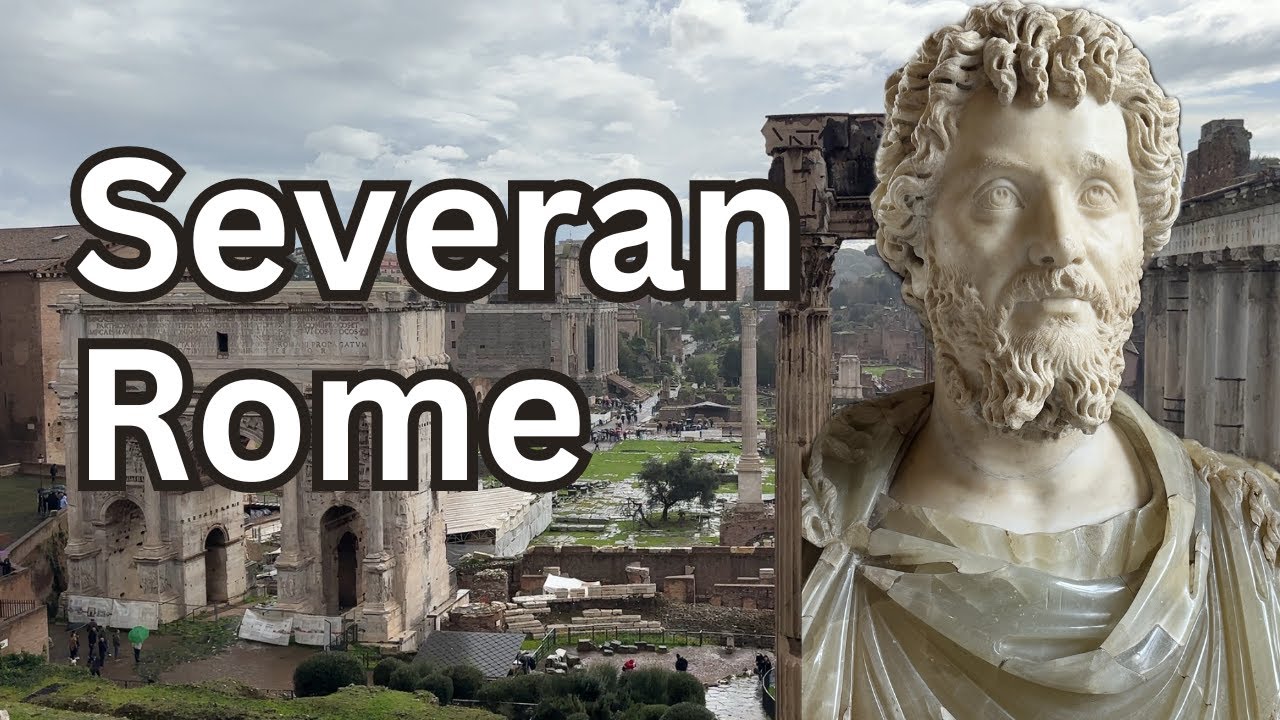Start with our video overview:
Septimius Severus founded the Severan Dynasty in 193 CE. It ushered in a period of stability following a civil war known as the Year of the Five Emperors, and it would last over forty years, ending in 235 CE with the assassination of emperor Severus Alexander.
The Severan Dynasty was responsible for constructing much of what can be seen today in the ruins of Ancient Rome. This includes the Arch of Septimius Severus, which celebrates his victory over the Parthians, and stands in the Roman Forum. On the Palatine Hill, Severus constructed the Septizodium, a monumental fountain that served as the terminus of the Via Appia. He also added an extension to the imperial palace known as the Domus Severiana. The most influential piece of Severan architecture was the Baths of Caracalla. Completed by Severus’ son and successor, the design of this structure is one of the few in the world that can accommodate such a massive interior space. As a result, its design has been replicated in basilicas and train stations across the globe, the most famous example being the original Pennsylvania Station in New York City.
It was the Severans who transformed Rome into a truly international city. Many of Severus’ top lieutenants were fellow North Africans, and it was during his reign that wealthy, provincial areas of the empire gained power and influence. This solidified an overarching Roman identity across the various ethnic groups that made up the empire. However, despite the order and stability that he brought, Severus used his position as emperor to fill his personal coffers and enrich his soldiers. This set a dangerous precedent, and it led to the avarice and tyranny that would come to define Rome and its emperors during the Crisis of the Third Century.
The women of the Severan Dynasty also played an important role in maintaining order and stability. The first woman of note is the empress Julia Domna, the wife of Severus. As the daughter of a Syrian high priest, she had strong political ties to the Near East. Her political connections, along with intelligence and insight, helped guide the political decisions of her sons Caracalla and Geta, who would succeed Severus as emperor. Julia Domna was also a patron of the arts, and helped restore the Temple of Vesta after it had been destroyed in a fire. Unfortunately, Julia Domna was unable to ease the enmity that existed between her two sons. In 211 CE, Caracalla murdered his younger brother Geta and damned his memory. When Caracalla was assassinated in 217 CE, Julia Domna took her own life. Her sister, Julia Maesa, succeeded her as imperial matriarch. She rallied the Syrian legions to defeat the usurper Macrinus and placed her grandson Elagabalus on the throne. However, neither Elagabalus nor his successor Severus Alexander, would achieve the same level of glory and military success as Septimius Severus. When Severus Alexander was assassinated by his own troops in 235 CE, the Severan Dynasty officially came to an end.
Bibliography
- Arya, Darius. “Julia Domna.” Ancient Rome Live. Last modified 3/29/2022. https://ancientromelive.org/juliadomna/
- Berick, Julia. “A Monument to Impermanence: The Death and Life of New York’s Penn Station.” Tenement Museum. https://www.tenement.org/blog/a-monument-to-impermanence-the-death-and-life-of-new-yorks-penn-station/
- Cartwright, Mark. “The Arch of Septimius Severus, Rome.” World History Encyclopedia, 31 Mar. 2024, www.worldhistory.org/article/502/the-arch-of-septimius-severus-rome/
- Grout, James. “The Severan Emperors.” University of Chicago. https://penelope.uchicago.edu/~grout/encyclopaedia_romana/severans/severans.html
- Lusnia, S. S. (2004). Urban Planning and Sculptural Display in Severan Rome: Reconstructing the Septizodium and Its Role in Dynastic Politics. American Journal of Archaeology, 108(4), 517–544. http://www.jstor.org/stable/40025729
This content is brought to you by The American Institute for Roman Culture, a 501(C)3 US Non-Profit Organization.
Please support our mission to aid learning and understanding of ancient Rome through free-to-access content by donating today.
Cite This Page
Cite this page as: Darius Arya, The American Institute for Roman Culture, “The Severan Dynasty” Ancient Rome Live. Last modified 09/27/2024. https://ancientromelive.org/the-severan-dynasty/
License
Created by The American Institute of Roman Culture, published on 09/27/2024 under the following license: Creative Commons: Attribution-NonCommercial-ShareAlike. This license lets others remix, tweak, and build upon this content non-commercially, as long as they credit the author and license their new creations under the identical terms. Please note that content linked from this page may have different licensing terms.



